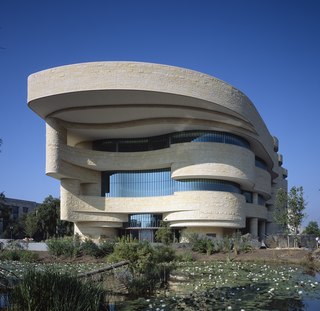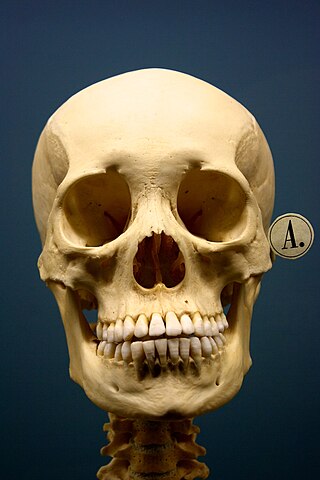
The Native American Graves Protection and Repatriation Act (NAGPRA), Pub. L. 101-601, 25 U.S.C. 3001 et seq., 104 Stat. 3048, is a United States federal law enacted on November 16, 1990.

The National Museum of the American Indian is a museum in the United States devoted to the culture of the indigenous peoples of the Americas. It is part of the Smithsonian Institution group of museums and research centers.

The National Museum of the American Indian–New York, the George Gustav Heye Center, is a branch of the National Museum of the American Indian at the Alexander Hamilton U.S. Custom House in Manhattan, New York City. The museum is part of the Smithsonian Institution. The center features contemporary and historical exhibits of art and artifacts by and about Native Americans.

Repatriation is the process of returning a thing or a person to its country of origin or citizenship. The term may refer to non-human entities, such as converting a foreign currency into the currency of one's own country, as well as to the process of returning military personnel to their place of origin following a war. It also applies to diplomatic envoys, international officials as well as expatriates and migrants in time of international crisis. For refugees, asylum seekers and illegal migrants, repatriation can mean either voluntary return or deportation.

George Gustav Heye was an American collector of Native American artifacts in the Western Hemisphere, particularly in North America. He founded the Museum of the American Indian, and his collection became the core of the National Museum of the American Indian.

Repatriation is the return of the cultural property, often referring to ancient or looted art, to their country of origin or former owners. The disputed cultural property items are physical artifacts of a group or society taken by another group, usually in the act of looting, whether in the context of imperialism, colonialism, or war. The contested objects vary widely and include sculptures, paintings, monuments, objects such as tools or weapons for purposes of anthropological study, and human remains.
According to Zuni mythology, Ahayu'da are the twin gods of war. They are also physical representations endowed with certain spiritual powers.

The Father Sebastian Englert Anthropological Museum is a museum in the town of Hanga Roa on Rapa Nui in Chilean Polynesia. Named for the Bavarian missionary, Fr. Sebastian Englert, OFM Cap., the museum was founded in 1973 and is dedicated to the conservation of the Rapa Nui cultural patrimony.

The Arizona State Museum (ASM), founded in 1893, was originally a repository for the collection and protection of archaeological resources. Today, however, ASM stores artifacts, exhibits them and provides education and research opportunities. It was formed by authority of the Arizona Territorial Legislature. The museum is operated by the University of Arizona, and is located on the university campus in Tucson.
The Association on American Indian Affairs is a nonprofit human rights charity located in Rockville, Maryland. Founded in 1922, it is dedicated to protecting the rights of Native Americans.

The repatriation and reburial of human remains is a current issue in archaeology and museum management, centering on ethical issues and cultural sensitivities regarding human remains of long-deceased ancestors which have ended up in museums and other institutions. Historical trauma as a result of colonialism is often involved. Various indigenous peoples around the world, such as Native Americans and Indigenous Australians, have requested that human remains from their respective communities be repatriated to their local areas and burial sites from various institutions, often in other countries, for reburial.

The Robert S. Peabody Institute of Archaeology, formerly known as the Robert S. Peabody Museum of Archaeology, is a learning center and archaeological collection in Andover, Massachusetts. Founded in 1901 through a bequest from Robert Singleton Peabody, an 1857 Phillips Academy alumnus, the institute initially held the archaeological materials collected by Peabody from Native American cultures. Peabody's passionate interest in archaeology led him to create the institute at Phillips Academy to encourage young people's interest in the sciences, and to foster respect and appreciation for the Native American peoples who have inhabited that hemisphere for thousands of years.
Pablita Abeyta was a Native American activist and sculptor born in Gallup, New Mexico, United States. The eldest daughter of Sylvia Ann (Shipley) Abeyta and artist Narciso Abeyta. Her family was originally from the Cañoncito Band of the Navajo Reservation in New Mexico, located west of Albuquerque. In 2000 the reservation decided to change its name to To’Hajiilee.

The Pompano Beach Mound, located at Indian Mound Park in Pompano Beach, Florida, in Broward County, is a 100-foot (30 m) wide, 7-foot (2.1 m) tall oval Tequesta burial mound. It was listed on the National Register of Historic Places on April 17, 2014.
"Found in collection" (FIC) is a term used by a museum to refer to "undocumented objects that remain without status after all attempts to reconcile them to existing records of permanent collection and loan objects are completed". Despite the best efforts of museum staff, museums often have FIC items. This term was developed so that collections with incomplete provenance would be handled ethically and with transparency. Depending on the paperwork and information accompanying the material, the museum has several choices in how to proceed.

The conservation and restoration of human remains involves the long-term preservation and care of human remains in various forms which exist within museum collections. This category can include bones and soft tissues as well as ashes, hair, and teeth. Given the organic nature of the human body, special steps must be taken to halt the deterioration process and maintain the integrity of the remains in their current state. These types of museum artifacts have great merit as tools for education and scientific research, yet also have unique challenges from a cultural and ethical standpoint. Conservation of human remains within museum collections is most often undertaken by a conservator-restorer or archaeologist. Other specialists related to this area of conservation include osteologists and taxidermists.
Osteoware is a free data recording software for human skeletal material that is managed through the Smithsonian Museum of Natural History. It is used by biological anthropologists to document data relevant to research and forensic applications of human skeletal remains in a standardized and consistent way. It has influenced other skeletal recording software, and has been successfully used at the Smithsonian for collecting data relevant to biological anthropology. Osteoware is the only free, individual-use software for the collection of data on skeletal material in anthropology.
Conservation and restoration at the Smithsonian Institution deals with the care of the 138 million artifacts located in the collections of Smithsonian Institution. Work is conducted by one research center, the Museum Conservation Institute (MCI), and by conservators at the Smithsonian's museums, galleries, zoo. Smithsonian conservators provide myriad services to their units, including exhibit preparation of the museum collection and loan objects, advising on object care, training for future generations of conservationists, engaging in routine preventive care on a daily basis, conducting research projects related to the collections, and examining objects for evidence of manufacturing techniques and previous restorations All conservation labs collectively further the mission of the Smithsonian Institution, "the increase and diffusion of knowledge." Founded in 1846 the Smithsonian is the world's largest museum and research complex, consisting of 19 museums and galleries, the National Zoological Park, and nine research facilities.

The exhibition of cultural property is a practice used by organizations where collected objects are put on display to the public. The objects are carefully chosen and placed together to offer educational value, and often to tell a story.
C. Maxx Stevens is an installation artist from the Seminole/Mvskoke Nation of Oklahoma. She often uses found objects and ephemera in her work which is centered on the concept of memories and stories. Stevens’ work has been described as “gritty and “both haunting and familiar” and prior installations have focused on the contemporary Native American experience such as the harmful effects of diabetes in Native American communities.













